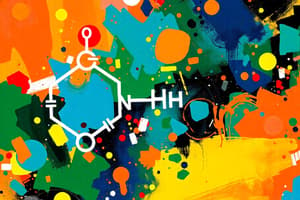Podcast
Questions and Answers
In an SN2 reaction, how does the hydroxide ion attack the carbon atom?
In an SN2 reaction, how does the hydroxide ion attack the carbon atom?
- By accepting a pair of electrons from the back side of the electrophilic carbon atom
- By donating a pair of electrons to the back side of the electrophilic carbon atom (correct)
- By accepting a pair of electrons from the front side of the electrophilic carbon atom
- By donating a pair of electrons to the front side of the electrophilic carbon atom
What happens to the leaving group in an SN2 reaction?
What happens to the leaving group in an SN2 reaction?
- It leaves with an additional pair of electrons
- It donates a pair of electrons to the carbon atom
- It leaves with the pair of electrons that once bonded it to the carbon atom (correct)
- It stays bonded to the carbon atom
What type of arrangement does the transition state of an SN2 reaction have?
What type of arrangement does the transition state of an SN2 reaction have?
- Linear arrangement of the carbon atom and the remaining three groups
- Tetrahedral arrangement of the carbon atom and the remaining three groups
- Planar arrangement of the carbon atom and the remaining three groups (correct)
- Octahedral arrangement of the carbon atom and the remaining three groups
What is the purpose of halogen exchange reactions?
What is the purpose of halogen exchange reactions?
How are alkyl iodides and fluorides synthesized using SN2 reactions?
How are alkyl iodides and fluorides synthesized using SN2 reactions?
Flashcards are hidden until you start studying
Study Notes
SN2 Reaction Mechanism
- Hydroxide ion attacks the carbon atom in a backside approach, which allows for optimal overlap between the nucleophile's electrons and the carbon's empty orbital.
- This backside attack results in a simultaneous bond formation between the hydroxide ion and the carbon atom while the existing bond to the leaving group breaks.
Leaving Group Behavior
- In an SN2 reaction, the leaving group is displaced as the nucleophile forms a new bond with the carbon atom.
- The departing leaving group typically becomes a stable species, often an anion or neutral molecule, depending on its nature and the reaction conditions.
Transition State Arrangement
- The transition state of an SN2 reaction has a trigonal bipyramidal arrangement.
- In this stage, the carbon atom is simultaneously bonded to three groups: the incoming nucleophile, the leaving group, and the remaining substituents.
Purpose of Halogen Exchange Reactions
- Halogen exchange reactions are used to selectively replace one halogen in a compound with another, which can modify chemical properties and reactivity.
- These reactions are important in synthetic organic chemistry for preparing various halogenated compounds with desired characteristics.
Synthesis of Alkyl Iodides and Fluorides
- SN2 reactions enable the synthesis of alkyl iodides by reacting alkyl halides with iodide ions, where iodide serves as a potent nucleophile.
- Alkyl fluorides can be achieved by employing fluorine sources such as potassium fluoride in an SN2 reaction, due to fluoride's strong electronegativity and ability to stabilize the negative charge.
Studying That Suits You
Use AI to generate personalized quizzes and flashcards to suit your learning preferences.




